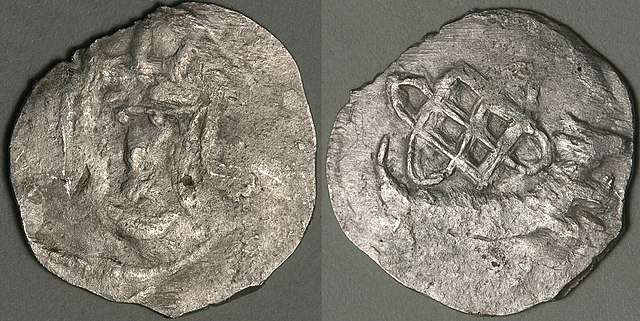The King Jagiełło Monument is an equestrian monument of Władysław II Jagiełło, King of Poland and Grand Duke of Lithuania, located in Central Park, New York City. The monument commemorates the Battle of Grunwald, a decisive defeat of the Teutonic Order in 1410. Originally made by Stanisław K. Ostrowski for the Polish 1939 New York World's Fair pavilion, the monument was permanently installed in Central Park in 1945. Raised on its grand plinth it is one of the most prominently sited and impressive of twenty-nine sculptures located in the park.
The King Jagiello Monument in 2010.
The monument in 1939
The monument and path by the pond
Jogaila, later Władysław II Jagiełło, was Grand Duke of Lithuania, later giving the position to his cousin Vytautas in exchange for the title of Supreme Duke of Lithuania (1401–1434) and then King of Poland (1386–1434), first alongside his wife Jadwiga until 1399, and then sole ruler of Poland. Born a pagan, he converted to Catholicism in 1386 and was baptized as Ladislaus in Kraków, married the young Queen Jadwiga, and was crowned King of Poland as Władysław II Jagiełło. In 1387, he converted Lithuania to Catholicism. His own reign in Poland started in 1399, upon the death of Queen Jadwiga, lasted a further thirty-five years, and laid the foundation for the centuries-long Polish–Lithuanian union. He was a member of the Jagiellonian dynasty in Poland that bears his name and was previously also known as the Gediminid dynasty in the Grand Duchy of Lithuania. The dynasty ruled both states until 1572, and became one of the most influential dynasties in late medieval and early modern Europe.

King Władysław II Jagiełło, detail of the Triptych of Our Lady of Sorrows in the Wawel Cathedral, Kraków
Early coin of the Grand Duke of Lithuania Jogaila with a lion, minted at the Vilnius Mint between 1386 and 1387
Seal of Jogaila with his title (in Latin) as King in Lithuania, used in 1377–1386, before becoming the King of Poland in 1386
Lithuanian Denar of Jogaila (minted in 1388–1392) with Vytis (Pahonia)







